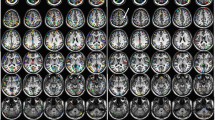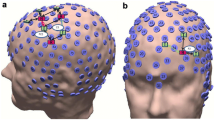We analyzed the topography and quantitative characteristics of changes in a blood oxygenation level-dependent (BOLD) signal accompanying movements of the fingers and hand performed by healthy humans. Three test movements characterized by different levels of complexity were united in an integrated paradigm of activation. We assumed that such a paradigm should promote the understanding of mechanisms of functioning of separate neuronal networks controlling motor functions and their grouping in scaling networks responsible for general control of motor activity by the CNS. Concurrently with the processes of activation of the sensorimotor network, we observed partial deactivation of certain nodi of the default-mode network (DMN) and formation of functional connectivities independent of the performance of the tasks. This confirms the statement on the heterogeneity of the DMN, whose different parts can be simultaneously desynchronized and can function in an offline mode. Analysis of the frequency spectrum of fluctuations of the BOLD signal allowed us to conclude that the sensorimotor network and DMN function simultaneously; however, each of them demonstrates direct (for the sensorimotor network) and inverse (for the DMN) correlation between changes in the BOLD signal and the successfulness of performance of the motor task.
Similar content being viewed by others
References
C. Stippich, B. Kress, H. Ochmann, et al., «Preoperative functional magnetic resonance tomography (FMRI) in patients with rolandic brain tumors: indication, investigation strategy, possibilities and limitations of clinical application,» Fortschr. Geb. Rontgenstr. Nuklearmed., 175, No. 8, 1042-1050 (2003).
J. D. Allison, K. J. Meador, D. W. Loring, et al., “Functional MRI cerebral activation and deactivation during finger movement,” Neurology, 54, No. 1, 135 (2000).
S. Ogawa, T. Lee, A. Kay, et al., “Brain magnetic resonance imaging with contrast dependent on blood oxygenation,” Proc. Natl. Acad. Sci. USA, 87, No. 24, 9868-9872 (1990).
G. L. Shulman, J. A. Fiez, M. Corbetta, et al., “Common blood flow changes across visual tasks: II. Decreases in cerebral cortex,” J. Cogn. Neurosci., 9, No. 5, 648-663 (1997).
Motor Cortex in Voluntary Movements: a Distributed System for Distributed Functions, A. Riehle and E. Vaadia (eds.), CRC Press, Boca Raton (2005).
Dysregulative Pathology of the Nervous System [in Russian], E. I. Gusev and G. N. Kryzhanovskii (eds.), “Med. Inform. Agenstvo,” Moscow (2009).
M. E. Raichle, A. M. MacLeod, A. Z. Snyder, et al., “A default mode of brain function,” Proc. Natl. Acad. Sci. USA, 98, No. 2, 676-682 (2001).
W. Gao, J. H. Gilmore, S. Alcauter, et al., «The dynamic reorganization of the default-mode network during a visual classification task,» Front. Syst. Neurosci., 7, 1-13 (2013).
M. D. Greicius, B. Krasnow, A. L. Reiss, et al., “Functional connectivity in the resting brain: a network analysis of the default mode hypothesis,” Proc. Natl. Acad. Sci. USA, 100, No. 1, 253-258 (2003).
A. R. Laird, S. B. Eickhoff, K. Li, et al., “Investigating the functional heterogeneity of the default mode network using coordinate-based meta-analytic modeling,” J. Neurosci., 29, No. 46, 14496-14505 (2009).
K. J. Friston, A. P. Holmes, K. J. Worsley, et al., “Statistical parametric maps in functional imaging: a general linear approach,” Hum. Brain Mapp., 2, No. 4, 189-210 (1994).
C. F. Beckmann and S. M. Smith, “Probabilistic independent component analysis for functional magnetic resonance imaging,” IEEE Trans. Med. Imaging, 23, No. 2, 137-152 (2004).
J. P. Kuhtz-Buschbeck, C. Mahnkopf, C. Holzknecht, et al., “Effector-independent representations of simple and complex imagined finger movements: a combined fMRI and TMS study,” Eur. J. Neurosci., 18, No. 12, 3375-3387 (2003).
Y. Liu, H. Shen, Z. Zhou, et al., “Sustained negative BOLD response in human fMRI finger tapping task,” PLoS One, 6, No. 8, e23839 (2011).
M. Rijntjes, C. Dettmers, C. Bьchel, et al., “A blueprint for movement: functional and anatomical representations in the human motor system,” J. Neurosci., 19, No. 18, 8043-8048 (1999).
P. Hlustэмk, A. Solodkin, R. P. Gullapalli, et al., “Functional lateralization of the human premotor cortex during sequential movements,” Brain Cogn., 49, No. 1, 54-62 (2002).
N. Picard and P. L. Strick, “Motor areas of the medial wall: a review of their location and functional activation,” Cerebr. Cortex, 6, No. 3, 342-353 (1996).
K. Sakai, O. Hikosaka, S. Miyauchi, et al., “Transition of brain activation from frontal to parietal areas in visuomotor sequence learning,” J. Neurosci., 18, No. 5, 1827-1840 (1998).
Author information
Authors and Affiliations
Corresponding authors
Rights and permissions
About this article
Cite this article
Omel’chenko, A.N., Rozhkova, Z.Z. Characteristics of fMRI Patterns during the Performance of Hand and Finger Movements of Different Complexity. Neurophysiology 48, 23–30 (2016). https://doi.org/10.1007/s11062-016-9565-y
Received:
Published:
Issue Date:
DOI: https://doi.org/10.1007/s11062-016-9565-y




